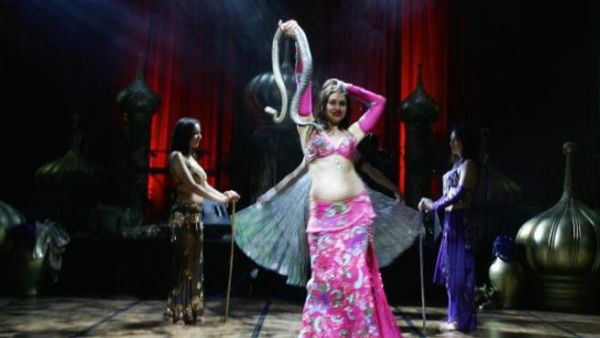Not only is the alarm of an "Islamist" clean sweep of Egypt making itself felt in the routine sensational reportage of the foreign media who have been ramping up the notion of no bikinis, booze or tourism for some time now, but locally there are some trades that will feel the pinch more than others. The good denizens of the capital of the Hollywood of the Middle East, are dreading the prospect of a hardline Muslim rule because it might strangle the arts. Nowhere more so than in the popular national exported trade of belly-dancing.
The spectre of the Muslim Brotherhood, now officially heading the race, seizing the helm of Egypt, is choking the politically, diametrically-opposed current, from the secularist, the leftist to the moderates across the board. It has also paralyzed the less politically-inclined artistic community of the entertainment industry in its wake. A sizeable group of literati, artists and entertainers, not least the belly dancer-brigade, fear that their livelihoods could suffer in a post-revoluton dark dawn.
An age-old tradition under threat
Egypt's belly dancing unions or guilds unite! Nowhere has this paranoia of a hard-line puritanical takeover penetrated more palpably than in the (seedy) underbelly of the nation, in the heart of the age-old belly dancing troupe. Belly-dancer Sophia, when interviewed on Egypt's electoral fate, does not shy from expressing concern for the future of the national dance form. It is not only in the interest of her own hip-jangling, but the tradition writ large. The entire exotified heritage of belly dancing hangs in the balance as run-offs bring the 'brother' against the old regime relic Ahmed Shafiq in a face-off. For Egypt, belly dancing is the oldest trade in the ancient history books and should garner some respect.
Another dancer who goes by Sama Al Masri, was curiously at peace with the eventuality of Islamic ascendancy. She defends the 'hood' and seems to show more loyalty to these brothers than her own sisters in the dancing profession. She is confident that they will support her career. It turns out she has an 'in' that should guarantee her a smooth ride into the new political era. She claims to have personal influential contacts of "Islamist" and "Salafi" affiliation who, she insists, show her only courtesy and respect. They keep themselves on the right side of Islamic propriety, tactfully avoiding direct contact with the pleasures of the flesh her world represents. She hopes they can come to some kind of compromise where they do not tread on her turf, nor she upset their new political order.
The contradicting outlooks of Sophia and Sama are not dissimilar to the binary intrinsic in the wider Egyptian society. Since the Brotherhood came to dominate parliament, the practical positions of the "Islamists and Salafis" are already rearing their Sharia heads on many issues, such as the trial of famous actor Adel Imam, who faced the courts over cinematic scenes deemed to be anti-Islamist. The powers that be insisted that alll dance or scenes of an initmate nature be censored out of his films.
It's not over til the Egyptian lady dances
These early responses put a blight on the future of the arts in general should the "Brotherhood" ascend to the presidency of Egypt. Some pose the question 'how can the revolution be upheld if women are prevented from dancing?'
While some Islamic scholars are likely to link the idea behind dancing to the seduction by Eve of Adam in paradise, others tie the roots of dancing to a pied piper who piped his flute prompting the snake to slide out of its basket, gyrating to the melody of the flute. This musical re-enactment of the historical snake that sowed the seed of disobedience and jeopardized the harvest of the fruit of the tree of life, makes some today still uneasy about the sanctity of music. Ergo dance and music are akin to seduction and evil.
Still, one cannot ignore the fact that dancing, an art-form and practice which is inherent in most societies, has a sacred place in mythology and cultural heritage. Forms of Salafi Islam may frown on music or other artistic depiction, but it has still flourished across all civilisations, no matter the religion or creed. There were dancing rituals in temples and holy sites to appease the gods, to call for rain, all the way until the present era where dancing has branched into a whole litany of forms and celebratory functions.
Between a dancer and a prophet
Famous dance seductions that might leave some clerics feeling safer with the snake back in the basket, include the ancient myth of Gilgamesh, where Enkidu was seduced by a harlot-dancer; as well as the high price that John the Baptist paid for the whims of a King faced with the dancing of 'femme fatale' Salome, who seduced this King of the Jews into granting her his head on a plate.
Dancing gradually moved from being a sacred ritual confined to the preserve of holy functions or superstition, to a more human everyday habit, albeit still associated with loss of control over faculties. The Greek god of indulgence and pleasure Bacchus leaves behind a direct association of dance with decadence and debauchery, hence bacchanalian.
Alongside its association with sin, poison and inpropriety, dancing has historically been equated to the sublime, serving a supreme purpose. Belly dance celebrates the female who gives rise to life. But this may be exactly what the Islamists are not interested in show-casing, or indeed unveiling - a female face to Egypt. Belly dance is as old as ancient Egypt of the Pharaohs. It started as a sacred fertility rite commemorating the glory of Mother Earth. "Indeed, it may have been the earliest form of childbirth preparation. The movements of belly dance serve to strengthen and prepare the very muscles a woman needs for a healthy natural labor and delivery."
Among the Egyptian hard-liners however the traditional belly dance form will come under the scrutiny of the more cynical who see the immorality it exotifies as a direct threat to conservative rule.
With the transcendent dance form that has crossed over from Arab East to West, the hip-shake, popularized by Shakira's honest hips, comes a legacy of civilizations. It has accompanied the cycle of life since time immemorial, and since there was 'light' there was 'dance'. Especially in Egypt where the Pharaohs sketched dancers on their walls alongside kings and gods. But Egypt today might have to look forward to a darker era, devoid of these pre-historic enlightened touches.
To dance or not to dance? Have your say in the comment space below.








